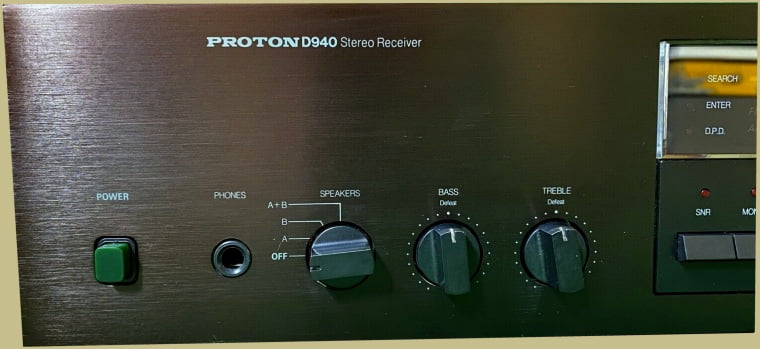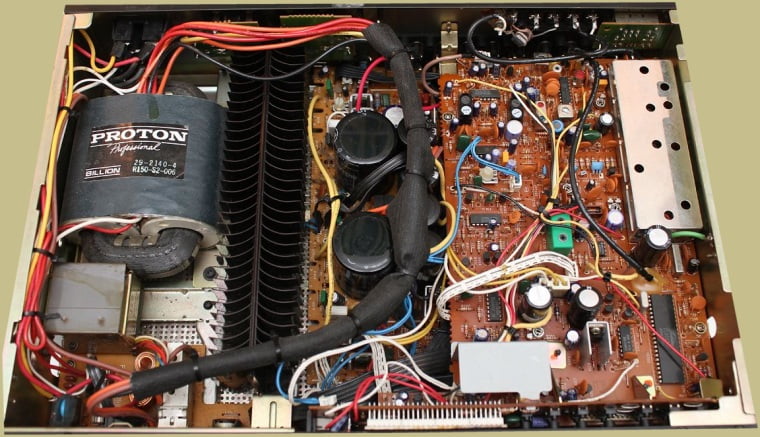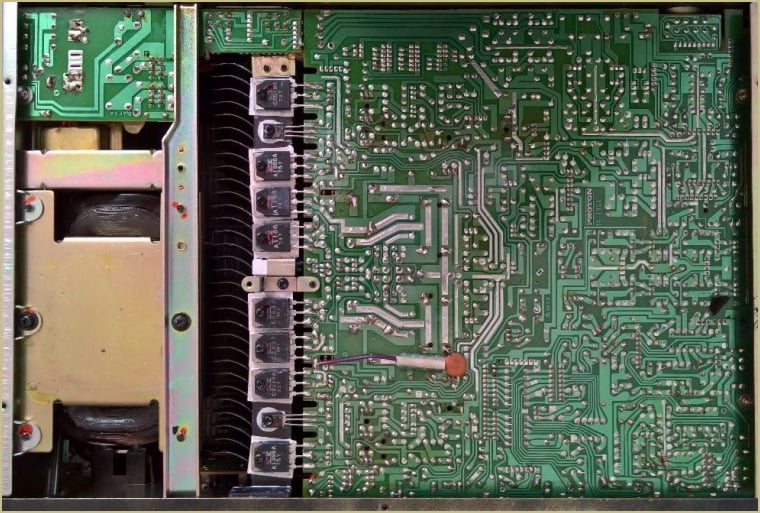
This Proton D940 from the early 1980’s is an interesting receiver. It has a lot of similarities to the NAD receivers of the time. That’s because NAD and Proton used the same manufacturer in Taiwan to produce their components. On the market from 1985 until 1991, the D940 produces 40 watts per channel and retailed for $449.95. It’s got a small footprint but packs a pretty good punch.

The Proton D940 has all the features you’d want but it’s mainly known for its Dynamic Power On Demand (DPD) feature. Its continuous power rating is 40 wpc but upon demand it can supply short term peaks of up to 160 wpc into 8 ohms or 280 wpc into 4 ohms. That’s some serious dynamic headroom.

The tuner on the D940 is interesting too. It utilizes the Schotz Noise Reduction, or SNR, circuit developed by Larry Schotz. The circuit is used to remove noise from FM broadcasts without altering frequency response. In short, it uses just the right amount of channel blend to reduce noise levels without harming stereo separation. This allows the D940 to bring in distant channels with great clarity. Ordinary noise reduction circuits can over blend the channels, especially when the signal is strong. You can activate or defeat the Schotz circuit via the button just below the tuning display.
There are station presets for 8 FM and 8 AM stations. Stations can be found via auto search, manual tuning or by entering the frequency numerically.

Specifications:
- Tuning range: FM, MW
- Power output: 40 watts per channel into 8Ω (stereo)
- Frequency response: 20Hz to 20kHz
- Total harmonic distortion: 0.02%
- Damping factor: 90
- Input sensitivity: 0.2mV (MC), 2.5mV (MM), 150mV (line)
- Signal to noise ratio: 75dB (MC), 92dB (MM), 105dB (line)
- Speaker load impedance: 2Ω to 8Ω
- Dimensions: 420 x 96 x 288mm / 16 1/2 x 3 3/4 x 11 1/3 inches
- Weight: 8.5kg / 18.7 pounds

There are a few common problems with the Proton D940 that need mentioned. The mode selector switch gets dirty and it is not easy to access in order to clean. In fact it’s difficult. This problem can cause the unit to jump between source inputs resulting in obvious problems. The other pots and switches usually need cleaning as well. Another issue is that the red Locked light will blink continuously and the FM station auto-search can become erratic. One owner stated:
…gave the upper IF transformer slug a gentle turn downwards – about one turn brought the TP1 voltage down to within a few millivolts of ground. LOCKED stopped flashing, stays on when properly tuned, and the auto-tune feature now works. Either the IF had drifted quite a lot in the past few decades, or this unit was never properly aligned in the first place.
A thread on some of these, and other, issues can be found HERE.

The back panel of the Proton D940 is packed. The inputs include, two for tape, phono, video, and DAD (digital audio device?). Notice the two green switches next to the Phono inputs? One is for switching between MM and MC phono cartridges. The other is for selecting either high or low gain for the MC cartridge. It will add 6dB of extra gain for very low output MC cartridges. There is even a 3-way phono capacitance switch at the top left corner of the back panel for use with moving magnet cartridges. Quite a bit of flexibility if you’re into vinyl.
The green switch next to the jumpers is to engage the Anti-Clipping Circuit (ACC). When depressed it will limit a waveform that might cause the amplifier to clip. It is recommended to utilize this circuit when playing CD’s at high volume.

Overall, the Proton D940 is a double edged sword of a receiver. It’s performance to price ratio is fantastic and its Schotz FM tuning circuitry is excellent. The Dynamic Power on Demand circuit provides exceptional headroom. But, the inherent problems with the selector switch, blinking Locked light and station tuning make it a problematic receiver. However, if you come across a D940 that is working properly, or you have the ability to restore one yourself, they are great receivers.
Thanks very much for this article. I just sent my 85 in for repair/cleaning, and plan to pair it with a new turntable. Question I am trying to figure out is, how do I add a subwoofer to this unit? Do I need a crossover? Didn’t proton make such a product in the day? Thank you!
If your speakers are any chop, try hitting the bass eq button, and you will have no need for a sub-woofer. If that’s not enough, add the loudness and take the bass up. I have overdriven bookshelf speakers this way, and their efforts are “admirable”! If you have a pair of willing 12-15″ woofers, tuned port, you will not be asking about sub-woofers. The D940 will snuff candles with bass.
DAD Digital Audio Disc
Showing my age now. Bought the D540 new in 86.
Bought another recently and paired it with a Proton 930 AM/FM receiver basically making a D940
I bought a D540 in 1986 when I was 18 and sold it over the years BIG mistake, a few months back I bought a D940 on eBay truly realised what a great sounding unit is and what I’ve been missing. Other components that I’m using with the D540 Thorens TD160 (original setup) Acoustic Reserch M1 speakers (over 30 years old) still sounding great and now with the proton these speakers have a sound I’ve never heard before such clean sound and the base his for the first time in 30 years DRM800 cassette deck. The D940 is a great sounding amplifier
I had a Proton amp in the mid 80s, wish I could remember the model, it would drive any speakers with ease. Also had a couple 22 watt Proton car amps driving mid/tweeters that were phenomenal.
I have a Sansui QRX 6500 that I want to sell. Do you buy them?
I have one of these in which the preamp sections works, but there is nothing from the power amp section output. Anyone have any ideas or know how to work on these?